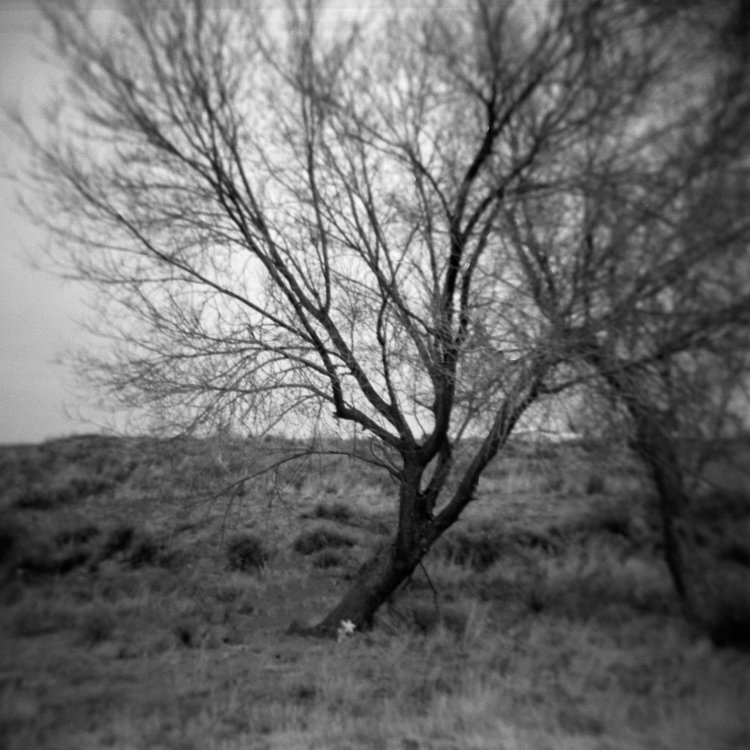The West Through a Plastic Lens
by E.E. McCollum
“West Begins” by E.E. McCollum
As a photographer, New Mexico intimidated me when I first moved here. Everywhere I looked was a grand landscape. But so many talented photographers had made such iconic images of New Mexico already. Who can forget Ansel Adams’ Moonrise, Hernandez, New Mexico for instance? Or Edward Weston’s photographs of White Sands? I often raised my camera to my eye as I drove or hiked through the mountains and high plains, only to lower it without releasing the shutter. What could I add to the legion of images we have seen on posters and in books, images that told us of the grandeur of the West, the challenge, the uncomplicated beauty. The grand landscape photographers also defined the technical standard of the time—fiercely in focus, long depth of field, awash with fine detail. It wasn’t until I began photographing with a Holga camera that I found a new vision of the land I now call home—a vision that is new to me, at least.
The Holga is a plastic camera, made in China, that is the darling of many fine art photographers. The plastic body doesn’t always fit together tightly. One must either tape it shut after each change of film, or embrace the light leaks that cast streaks across the images it produces. Even the lens is plastic, not optically whole, and it creates dream-like, blurry images with varying areas of focus across the frame. The Holga isn’t cut out for grand landscapes. It is the technical antithesis of the standard set by the photographers of grand landscapes. But it led me to something else, something as Western as long expenses of mountains, horizons and prairie. It led me to ungrand moments, details, and scenes that speak to an interior experience rather than an exterior one. Sometimes tack sharp photographs hold us at arm's length, I think, while less precise images invite us in. My little Holga led me to aesthetic places I wouldn't have found had all those wonderful photographers not photographed the grand landscapes so sublimely.
Note from the Editor:
Some web browsers may crop the following images; please click on the individual images to view the complete composition as intended by the artist.
"West Begins" (2020) by E.E. McCollum
"Chama River" (2021) by E.E. McCollum
"Abandoned Guitar Store - Tucumcari, NM" (2021) by E.E. McCollum
"Adobe Walls" (2020) by E.E. McCollum
"Always Rejoice" (2022) by E.E. McCollum
"Lamy Railyard" (2020) by E.E. McCollum
"Conchas Lake" (2021) by E.E. McCollum
"Cross" (2021) by E.E. McCollum
"Coneflowers" (2021) by E.E. McCollum
"Cypress Trees" (2021) by E.E. McCollum
"Dark Bird" (2021) by E.E. McCollum
"Cottonwood" (2021) by E.E. McCollum
"God" (2021) by E.E. McCollum
"Juniper" (2020) by E.E. McCollum
"Lamy, NM" (2021) by E.E. McCollum
"Number 8" (2020) by E.E. McCollum
"Shrine" (2021) by E.E. McCollum
"Squash Blossoms" by E.E. McCollum
"Star Tree" (2022) by E.E. McCollum
"Think Big" (2021) by E.E. McCollum
"Three White Sticks" (2021) by E.E. McCollum
"Waldo, NM" (2022) by E.E. McCollum
"White Chairs on the Pecos" (2021) by E.E. McCollum
"Where is here" (2022) by E.E. McCollum
E. E. McCollum is a writer and fine art photographer who works in both digital and analog formats to produce primarily black and white images. A native of Iowa, McCollum spent 26 years in the greater Washington, DC, area, but relocated to Santa Fe, NM, four years ago. He and his wife—both Midwesterners who met while living in Topeka, KS—missed the West and McCollum decided he didn't want to die looking at the traffic on I-95. An aging hippie, McCollum lived in Santa Fe in the early 1970s, so his return felt something like a homecoming. McCollum has been making photographs since elementary school and became serious about fine art photography in 2004. A formative earlier experience was taking a course in the history of photography with Beaumont Newhall in the early ‘70s at the University of New Mexico. McCollum's photographic work has been published in Lenswork, Adore Noir, Shadow & Light Magazine , PH Magazine, Digital Photographer (UK), Stern (Germany - online), Madame (Germany), Kinfolk (Denmark), and elsewhere. He has exhibited his work in both solo and group shows for the past 15 years. As a writer, McCollum has written a regular column for the past six years for Shadow & Light Magazine, focused not on the technical aspects of photography, but on the experience of making photographs and on the issues that arise when doing so. He has also published nonfiction—years ago—in The North American Review, and poems in Kansas Quarterly and Little Balkans Review (a regional Kansas journal, now defunct). He is currently at work on projects that combine text and photographs.
Contact: info@eemccollum.com
Website: www.eemccollum.com
IG: @eemccollum



























